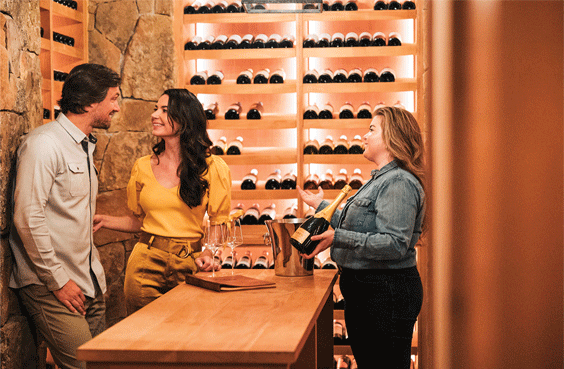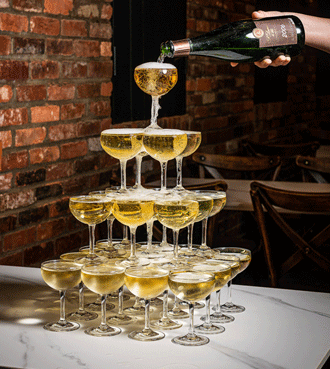Thanks to a plethora of new styles and products, it’s a thrilling time for sparkling wine.
Sparkling wine has come into its own as a beverage that transcends celebratory toasts. As author Hester Browne quipped, “Always keep a bottle of Champagne in the fridge for special occasions. Sometimes, the special occasion is that you’ve got a bottle of Champagne in the fridge.”
Indeed, that adage can be expanded to include all of the exciting global options available these days, from the tried-and-true to the emerging – which should be savored, not saved. It helps that sommeliers extol sparkling wine’s effortless food-friendliness with everything from fried chicken to foie gras, plus wine drinkers today are increasingly eager to venture into various styles, regions and varieties.
Champagne Wishes and Cremant Dreams
The eternal, ultimate standard for sparkling wine, Champagne continues to attract imbibers drawn to its heritage, production method, quality and prestige. But its popularity is widening from non-vintage (and vintage) expressions from well-known houses to those that represent a larger swath of the category.
“We are taking a modern approach to Champagne with our list in general, with a stronger emphasis on grower Champagnes and terroir-driven Champagnes,” says Erin Dudley. She oversees the wine program for Josephine, a new 285-seat French brasserie in Old Town Alexandria, VA, as part of her role as wine director for Neighborhood Restaurant Group.
At Josephine, Dudley’s wine program has a strong focus on French sparkling wines, specifically Champagne, with very few well-known houses represented. She offers 10 sparkling wines by the glass, including four Champagnes, all available in a 3-oz. coupe or a 5-oz. glass; prices range from $7 to $17 for the former, and $12 to $28 for the latter. Champagne options include Klepka Sausse Champagne “Pream-Bulle” Grand Cru ($16/$27), Louis Dumont Champagne Rosé ($15 for a 3-oz. coupe; $25 a 5-oz. glass) and Charles Orban Carte Noire Champagne Brut ($17/$28).
While Dudley strives to always have a blanc de blancs, blanc de noirs, classic blend and rosé Champagne available by the glass, the list reaches well beyond that. “We make sure to offer a wide range of sparkling wine styles, from bone dry and mineral to round and fruity.”
She’s particularly excited about crémants, traditional-method French sparkling wines produced in other areas besides Champagne, especially those made in the Jura region between Switzerland and Burgundy. “These wines, often made of chardonnay and/or pinot noir in the sub-Alpine region, are beautifully round and luscious at a fraction of the price of Champagne.” One example is the Patrick Bottex “La Cueille” Bugey Cerdon Rosé ($11 for 3-oz. $18 for 5-oz.).
Other Crémants at Josephine include the Salasar Carte Azur, Crémant de Limoux Brut ($7/$12), and the Paul Buisse Crémant de Loire Rosé ($8/$14). Guests often take advantage of the 3-oz. pours as an opportunity to create their own mini-tastings of Champagne or other fizzy flights.
Historic New Orleans restaurant Commander’s Palace this past August launched Commander’s Palace Cuvée Brut, a Crémant de Bourgogne. Produced in partnership with Terres Secrètes and made with grapes from the Mâconnais region of Burgundy, the pinot noir-based sparkling wine is now available for purchase online for nationwide shipping, with a suggested retail price of $42. The private-label sparkler is also offered at the restaurant by the half-glass ($7.50), glass ($15) and bottle ($68).

At Brush Creek Ranch, three different, all-inclusive properties in Wyoming’s North Platte River Valley with five dining concepts, Victorine de Chastenay Crémant de Bourgogne is included for resort guests. Since it hails from a producer who focuses on sparkling, the wine is on par with expressions from neighboring Champagne, says wine director Sydney Werry.
“The quality is incredible, and I love that it’s a blend of all four legal grapes in Burgundy,” she says. “Fresh and bright with notes of citrus zest, almond and a long finish, it’s the perfect apéritif or pairing with a salad or fish dish.”
The resort, set on a 30,000-acre working cattle ranch, boasts the underground Brush Creek Cellar, a 94-yard cellar holding 35,000 bottles. The depth and breadth of the list, Werry believes, encourages an increased enthusiasm for guests to venture into uncharted territory. This includes the sparkling wine category, whether it’s a bottle from a previously unavailable vintage or one from an up-and-coming region.
Werry has been exploring “tasty and fresh” bubbly from Mexico’s Baja California region, where the warm Mediterranean climate is moderated by the Pacific and a range of microsites. Quality producers to seek out from the area include Symmetria, Casa Vegil and Pouya.
“I think we’re living in the golden age of sparkling wine, and I hope we can keep it that way,” says Tucker Hurley, general manager of Le French Wine Shop in New York. He believes that “the winemakers who focus on sustainability and respect for the planet will ultimately come out on top.”
To that end, the shop just started carrying Champagne Telmont “Reserve de la Terre” (priced at $159), the first Champagne to receive the organic AB (Agriculture Biologique) certification. The attention to detail extends to the packaging, produced with recycled and biodegradable materials; eco-friendly hemp rope replaces wire cages.
In a diverse market such as New York, Hurley says it’s important to offer a wide selection of sparkling wine. “When you describe a ‘brut nature’ or ‘pét-nat,’ it’s like you are introducing them to a new type of cuisine that they may have only previously read about.” Domaine du Pas Saint Marin La Vie en Rose ($29) is an organic pét-nat from the Loire Valley, made from grolleau.
Le French Wine Shop focuses exclusively on bottles from all corners of France, and will soon be launching a monthly wine club. Of course, the diversity of tastes found in New York is also the reason the store stocks classic Champagne, including Canard Duchene Brut Rosé Champagne ($69), Billecart-Salmon Brut Rosé Champagne ($99) and Henriot Brut Souverain Champagne ($69).
“For me, Henriot really embodies tradition and excellence in Champagne,” Hurley says. “They’ve been winemakers since 1808, and their blend of pinot noir and chardonnay is largely made from premier cru and grand cru wine – it’s very elegant.”
Age Statements
Champagne – and other traditional-method sparkling wines – labeled “non-vintage” or “NV” are ready to be consumed without any additional maturation required. In fact, some producers discourage storing these for extended lengths of time, lest they lose their freshness and vibrancy.
But what happens if you flout that rule? At Grill 23 & Bar, a 400-seat chophouse in Boston, beverage director and advanced sommelier Hugo Bensimon is on a quest to find out by aging non-vintage styles for a few years.
“We’ve aged some wines that are ‘base bottlings’ of producers, some of which aren’t that expensive, and seen them completely change paths,” he admits. “You can turn a $30 bottle into something that’s amazing, with just a little patience.”
Grill 23 & Bar offers more than 200 sparkling wines priced from $44 to $9,000 per bottle, in all styles and categories – even sparkling riesling from Germany that dates back to 1984. “I’m encouraged by how many more people are drinking Champagne today than in years past,” Bensimon says. “It seems to have finally crossed the threshold of not only being opened on special occasions.”
Of Grill 23 & Bar’s three sparklers by the glass, two are Champagne: Vilmart & Cie “Grand Cellier” Brut Champagne ($43) and J. Lassalle ‘Préférence’ Premier Cru Brut Champagne ($28). The other option is Zonin prosecco ($13).

Italian-Style Sparklers
Speaking of prosecco, whether in a Mimosa or as an apéritif, its popularity isn’t waning. But this Italian Charmat-method sparkling wine hailing from the Conegliano Valdobbiadene region of the Veneto is no longer always a simple, easy-drinking quaffer.
At Stirrups, the 150-seat steakhouse and seafood restaurant at the 248-room Equestrian Hotel at the World Equestrian Center in Ocala, FL, beverage director Roland Micu delights and surprises guests when he pours the Giusti Asolo Prosecco Superiore DOCG Brut. Full-bodied and structured, it boasts vibrant acidity and more complexity than some of its Veneto cousins and over-delivers for $40 a bottle.
“Many proseccos lack the acidity to balance the sugar content, but Giusti is a Champagne drinker’s prosecco,” Micu says. A temperature-controlled primary fermentation results in a fresh and clean flavor, he says.
Stirrups has 41 sparkling wines by the bottle priced $40 to $4,200 (for a vintage magnum), and three by the glass: Col de Salici Prosecco ($11), Veuve Clicquot Champagne Brut ($35) and Placido Moscato d’Asti ($9).
Panorama Wine Bar, a 147-seat concept in the 51-room Penn’s View Hotel in Philadelphia, offers more than 120 wines on tap and 30 tasting flights, including 11 sparkling wines. General manager and wine director William Eccleston says that the 2020 Prosecco Rosé “Treviso” Ruggeri ($15 a glass, $75 a bottle) “takes prosecco to a new level with the extra depth of flavor pinot noir can add to any sparkling wine.”
Eccleston offers other Italian sparklers at Panorama Wine Bar, including Antica Fratta Brut Franciacorta NV ($22 a glass, $110 a bottle), Italy’s traditional method answer to Champagne. And he sells three different styles of Lambrusco, from dry to amabile (slightly sweet).
These include Lini 910 Lambrusco Bianco dell’Emilia ($16 a glass, $80 a bottle), Lini 910 Lambrusco Rosso dell’Emilia ($16 a glass, $80 a bottle) and Cantina Settecani Lambrusco Grasparossa di Castelvetro Amabile ($17 a glass, $85 a bottle.) “This shines a light on this traditional yet often underexplored style of sparkling that pairs especially well with tomato sauce and other Italian menu items,” Eccleston says.
Brut nature styles, which are bone dry with zero dosage, are also one of Eccleston’s growing interests, as are pours from up-and-coming regions. “The Sidó—nio de Sousa Brut Nature Branco Bairrada Metodo Classico from Portugal [$15 a glass, $75 a bottle] particularly turns heads as my own pet recommendation for a great value sparkling wine that is polished, stylish, and well-crafted from an area that has really stepped up the quality of their winemaking in recent years.”
It’s yet another example of the sparkling surprises that continue to bubble up all over.
Kelly Magyarics, DipWSET, is a wine, spirits, travel and lifestyle writer in the Washington, D.C. area.









